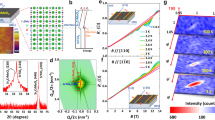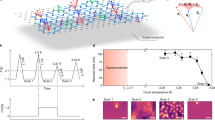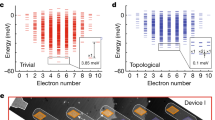Abstract
The intriguing idea that strongly interacting electrons can generate spatially inhomogeneous electronic liquid-crystalline phases is over a decade old1,2,3,4,5, but these systems still represent an unexplored frontier of condensed-matter physics. One reason is that visualization of the many-body quantum states generated by the strong interactions, and of the resulting electronic phases, has not been achieved. Soft condensed-matter physics was transformed by microscopies that enabled imaging of real-space structures and patterns. A candidate technique for obtaining equivalent data in the purely electronic systems is spectroscopic imaging scanning tunnelling microscopy (SI-STM). The core challenge is to detect the tenuous but ‘heavy’ momentum (k)-space components of the many-body electronic state simultaneously with its real-space constituents. Sr3Ru2O7 provides a particularly exciting opportunity to address these issues. It possesses a very strongly renormalized ‘heavy’ d-electron Fermi liquid6,7 and exhibits a field-induced transition to an electronic liquid-crystalline phase8,9. Finally, as a layered compound, it can be cleaved to present an excellent surface for SI-STM.
This is a preview of subscription content, access via your institution
Access options
Subscribe to this journal
Receive 12 print issues and online access
$259.00 per year
only $21.58 per issue
Buy this article
- Purchase on SpringerLink
- Instant access to full article PDF
Prices may be subject to local taxes which are calculated during checkout



Similar content being viewed by others
References
Kivelson, S. A., Fradkin, E. & Emery, V. J. Electronic liquid-crystal phases of a doped Mott insulator. Nature 393, 550–553 (1998).
Fradkin, E. & Kivelson, S. A. Liquid-crystal phases of quantum Hall systems. Phys. Rev. B 59, 8065–8072 (1999).
Halboth, C. J. & Metzner, W. d-wave superconductivity and Pomeranchuk instability in the two-dimensional Hubbard model. Phys. Rev. Lett. 85, 5162–5165 (2000).
Yamase, H. & Kohno, H. Instability toward formation of quasi-one-dimensional Fermi surface in two-dimensional t–J model. J. Phys. Soc. Jpn 69, 2151–2157 (2000).
Zaanen, Z., Nussinov, Z. & Mukhin, S. I. Duality in 2+1D quantum elasticity: Superconductivity and quantum nematic order. Ann. Phys. 310, 181–260 (2004).
Tamai, A. et al. Fermi surface and van Hove singularities in the itinerant metamagnet Sr3Ru2O7 . Phys. Rev. Lett. 101, 026407 (2008).
Borzi, R. A. et al. de Haas–van Alphen effect across the metamagnetic transition in Sr3Ru2O7 . Phys. Rev. Lett. 92, 216403 (2004).
Perry, R. S. et al. Multiple first-order metamagnetic transitions and quantum oscillations in ultrapure Sr3Ru2O7 . Phys. Rev. Lett. 92, 166602 (2004).
Grigera, S. A. et al. Disorder-sensitive phase formation linked to metamagnetic quantum criticality. Science 306, 1154–1157 (2004).
Borzi, R. A. et al. Formation of a nematic fluid at high fields in Sr3Ru2O7 . Science 315, 214–217 (2007).
Crommie, M. F., Lutz, C. P. & Eigler, D. M. Imaging standing waves in a two-dimensional electron gas. Nature 363, 524–527 (1993).
Petersen, L., Hofmann, Ph., Plummer, E. W. & Besenbacher, F. Fourier transform–STM: Determining the surface Fermi contour. J. Electron Spectrosc. Relat. Phenom. 109, 97 (2000).
Hoffman, J. E. et al. Imaging quasiparticle interference in Bi2Sr2CaCu2O8+d . Science 297, 1148–1151 (2002).
Wang, Q.-H. & Lee, D.-H. Quasiparticle scattering interference in high-temperature superconductors. Phys. Rev. B 67, 020511 (2003).
McElroy, K. et al. Relating atomic-scale electronic phenomena to wave-like quasiparticle states in superconducting Bi2Sr2CaCu2O8+δ . Nature 422, 592–596 (2003).
Capriotti, L., Scalapino, D. J. & Sedgewick, R. D. Wave-vector power spectrum of the local tunneling density of states: Ripples in a d-wave sea. Phys. Rev. B 68, 014508 (2003).
Nunner, T. S., Chen, W., Andersen, B. M., Melikyan, A. & Hirschfeld, P. J. Fourier transform spectroscopy of d-wave quasiparticles in the presence of atomic scale pairing disorder. Phys. Rev. B 73, 104511 (2006).
Hanaguri, T. et al. Quasiparticle interference and superconducting gap in Ca2−xNaxCuO2Cl2 . Nature Phys. 3, 865–871 (2007).
Singh, D. J. & Mazin, I. I. Electronic structure and magnetism of Sr3Ru2O7 . Phys. Rev. B 63, 165101 (2001).
Iwaya, K. et al. Local tunneling spectroscopy across a metamagnetic critical point in the bilayer ruthenate Sr3Ru2O7 . Phys. Rev. Lett. 99, 057208 (2007).
Kohsaka, Y. et al. An intrinsic bond-centered electronic glass with unidirectional domains in underdoped cuprates. Science 315, 1380–1385 (2007).
McElroy, K. et al. Elastic scattering susceptibility of the high temperature superconductor Bi2Sr2CaCu2O8+x: A comparison between real and momentum space photoemission spectroscopies. Phys. Rev. Lett. 96, 067005 (2006).
Chatterjee, U. et al. Nondispersive fermi arcs and the absence of charge ordering in the pseudogap phase of Bi2Sr2CaCu2O8+d . Phys. Rev. Lett. 96, 107006 (2006).
Kim, E.-A. & Lawler, M. J. Interference of nematic quantum critical quasiparticles: A route to the octet model. Preprint at <http://arxiv.org/abs/0811.2242> (2009).
Binz, B. & Sigrist, M. Metamagnetism of itinerant electrons in multi-layer ruthenates. Europhys. Lett. 65, 816–822 (2004).
Kee, H. Y. & Kim, Y. B. Itinerant metamagnetism induced by electronic nematic order. Phys. Rev. B 71, 184402 (2005).
Berridge, A.M. et al. Inhomogeneous magnetic phases: A LOFF-like phase in Sr3Ru2O7 . Phys. Rev. Lett. 102, 136404 (2009).
Raghu, S. et al. Microscopic theory of the nematic phase in Sr3Ru2O7 . Phys. Rev. B 79, 214402 (2009).
Lee, W.C. & Wu, C. Nematic electron states enhanced by orbital band hybridization. Preprint at <http://arxiv.org/abs/0902.1337> (2009).
Farrell, J. E. The Influence of Cation Doping on the Electronic Properties of Sr3Ru2O7. PhD thesis, Univ. St Andrews; available at <http://hdl.handle.net/10023/689>.
Acknowledgements
We acknowledge and thank E. Fradkin, T. Hanaguri, C. A. Hooley, E.-A. Kim, S. A. Kivelson, Y. Kohsaka, M. J. Lawler, A. J. Millis, S. Raghu, T. M. Rice, S. Sachdev, K. M. Shen, H. Takagi, A. Tamai and F.-C. Zhang for helpful discussions and communications. These studies are carried out with support from NSF DMR-0520404 to the Cornell Center for Materials Research, from Brookhaven National Laboratory and from the UK EPSRC, Royal Society and Leverhulme Trust.
Author information
Authors and Affiliations
Contributions
The crystals were grown by J.F., SI-STM experiments were carried out by J.L., M.P.A. and M.A.W. and project planning, data analysis and paper-writing were done by J.L., M.P.A., S.A.G., F.B., J.C.D. and A.P.M.
Corresponding author
Supplementary information
Supplementary Information
Supplementary Information (PDF 405 kb)
Rights and permissions
About this article
Cite this article
Lee, J., Allan, M., Wang, M. et al. Heavy d-electron quasiparticle interference and real-space electronic structure of Sr3Ru2O7. Nature Phys 5, 800–804 (2009). https://doi.org/10.1038/nphys1397
Received:
Accepted:
Published:
Issue date:
DOI: https://doi.org/10.1038/nphys1397
This article is cited by
-
Spin-orbit coupling induced Van Hove singularity in proximity to a Lifshitz transition in Sr4Ru3O10
npj Quantum Materials (2024)
-
Nano-imaging of strain-tuned stripe textures in a Mott crystal
npj Quantum Materials (2021)
-
Emergent charge order near the doping-induced Mott-insulating quantum phase transition in Sr3Ru2O7
Communications Physics (2019)
-
Imaging orbital-selective quasiparticles in the Hund’s metal state of FeSe
Nature Materials (2018)
-
Quasiparticle interference and strong electron–mode coupling in the quasi-one-dimensional bands of Sr2RuO4
Nature Physics (2017)



